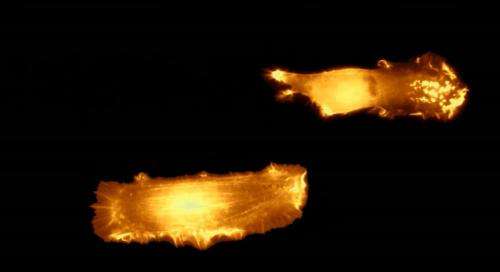Scientists bringing cells on the fast track

During cancer metastasis, immune response cells are moving in a controlled manner through the body. Researchers from the Department of Biomedicine at the University of Basel discovered novel mechanisms of cell migration by observing cells moving on lines of connective tissue. Their results, published in the journal Developmental Cell, could lead to new approaches in combatting cancer metastasis and inflammation.
Cells migrate by connecting their cytoskeleton – a network made up of proteins – to adhesion molecules which in turn get in contact with the surrounding connective tissue. In order to guide cells in a certain direction a signal from outside is needed, which leads then to cell polarization and coordinated mechanical movement. A fundamental question is how signaling pathways are regulated in time and space to facilitate directional migration of cells.
Classical cell migration experiments use uniformly coated glass plates with the drawback that cells adhere very strongly to the glass surface and move randomly in any direction. This random cell movement aggravates comprehensive studies of directional cell migration.
Mimicking organisms
In their study, scientists around Prof. Olivier Pertz from the Department of Biomedicine at the University of Basel gained novel insights into the regulation of directional cell migration: Using a special procedure, 20 micrometer wide lines were fabricated on glass thereby mimicking the connective tissue environment – creating a highway for cells. In addition, cells were stimulated with a growth factor (PDGF) which led to fast cell migration in only one direction lasting for many hours.
"This shows that we can achieve robust and directional cell migration by mimicking the geometry of connective tissue as we find it in the body," tells Olivier Pertz. Certain dot-like structures, that are always located at the front of the cell, adopt a crucial role in maintaining long term polarized cell migration.
The research results give novel insights into how signaling pathways are regulated in time and space in order to facilitate migration of cells only in one direction. The scientists describe novel concepts of cell migration, which could help to find new targets and approaches to fight cancer metastasis and inflammation. "The more insights we get into the mechanisms of cell migration, the more effectively and focused we will be able to intervene in certain pathological processes," first author Dr. Katrin Martin comments.
More information: Katrin Martin, Marco Vilela, Noo Li Jeon, Gaudenz Danuser, Olivier Pertz. "A Growth Factor-Induced, Spatially Organizing Cytoskeletal Module Enables Rapid and Persistent Fibroblast Migration." Developmental Cell, Volume 30, Issue 6, 29 September 2014, Pages 701–716 | DOI: 10.1016/j.devcel.2014.07.022

















